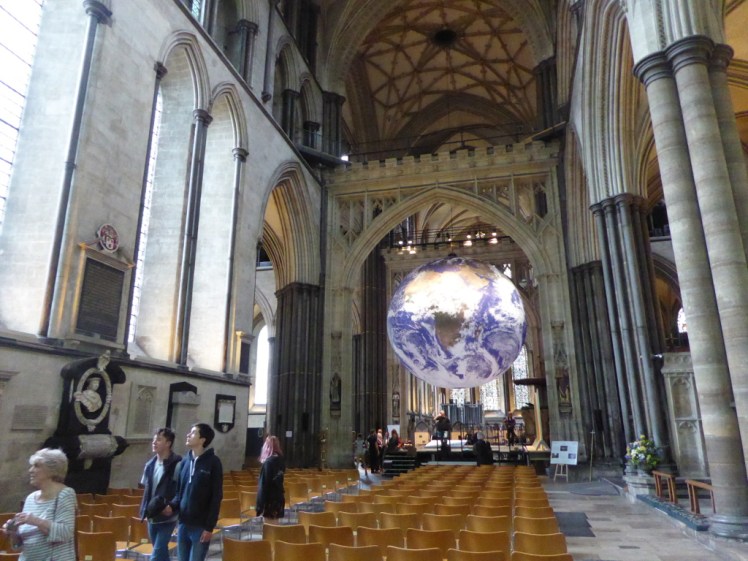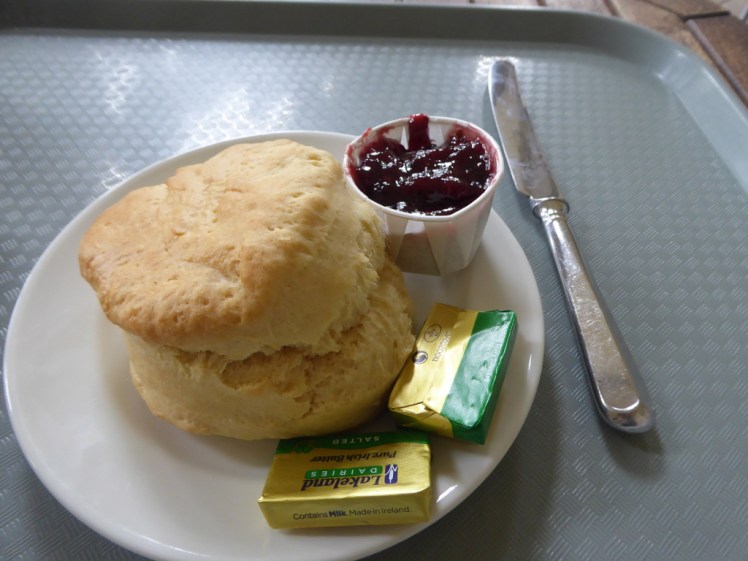Following the Notre Dame fire, my trip to Winchester and to the Sistine Chapel, the next stop on my “before it burns down” tour was Salisbury Cathedral. I mean, if it’s worth coming all the way from Moscow to see, it’s worth coming from Wessex to see. Easily done because my car spent eight hours in a garage there last week having its service, MOT and £400-worth of repairs done. Please understand therefore why I’m leaving my Ko-fi link here with a plea for a few of your pennies, if you’re feeling really kind.

While I was waiting, of course, I went to the cathedral – only to find that it was closed until 3pm for some kind of school competition. The Chapter House was still open and the Chapter House contains something rather special.

It’s not the expanses of stained glass, making this more of a light and airy summerhouse. It’s not the medieval frieze (I borrowed the information board on the subject and carried it around to identify each scene. Have a picture of the Drunkenness of Noah, to go with the Michaelangelo painting of the same subject on the Sistine Ceiling.)

No, the special thing in the Chapter House is the Salisbury Magna Carta, one of only four surviving manuscripts. I understand there was once one for just about every town, something like that, but this was eight hundred years ago; documents vanish between the morning they arrive in the post and the next day when you wish to do something about them so you can’t expect many to survive the best part of a whole millennium.

Magna Carta – not the Magna Carta, apparently – was a charter of rights, a document signed by the king listing the freedoms and liberties of the people. Well, more the barons, landowners and rich folk than the ordinary people. Still, it was more than had existed before. It’s written in tiny letters, full of space-saving abbreviations and bereft of paragraph breaks and anything that makes it readable. And it’s written in medieval Latin. Even with my nose almost touching the glass, all I could decipher was a medieval version of John and the words Rex Anglie, King of England. Beyond that, I couldn’t pick out a word, let alone translate it. I came back later in the afternoon, after a 5km walk, the purchasing of a Teach Yourself Russian course (Duolingo is not working), a pub lunch, a short writing session in the library and a couple of Car Emergency Surgery phone conversations to explore inside the cathedral.

Honestly? Not as good as Winchester. The spire is good but you can’t get inside the spire and the only people who get to climb the outside are Blue Peter presenters. The tower tour wasn’t available – I’d never noticed that the spire sits on a fairly short stumpy square tower that has more than a hint of the Norman about it.
I had heard that Salisbury was one of the cathedrals built by William the Conqueror, a set of not-quite-matching grey stone three-storey Norman edifices. I know Winchester was extensively rebuilt in Perpendicular Gothic style but Salisbury is just so different, I couldn’t reconcile it. Turns out old Bill built the long-gone Old Sarum Cathedral in Norman style and the current Salisbury Cathedral came along in 1220, less than 150 years later. Old English style, if you’re interested.

Winchester’s nave feels higher, more soaring. It’s a lot lighter, thanks mostly to the destruction of the stained glass windows by the Roundheads around 1650. Most importantly, Winchester does not have the view impeded by a giant rotating globe. Oh yeah, it’s a great work of art and people were fascinated to see where places actually are, how far north they really are – but I can’t see down the cathedral because of it!

Also, everything east of the transepts is closed for renovation. I understand that it’s an ancient cathedral and it needs work to keep it upright but it’s frustrating to not be able to get at nearly half the building. The organ is also being restored and it’s lying in pieces behind a wall in the north transept, further limiting what I can see. Oh, and there’s a stage up underneath the globe for the school competition so you can’t see down the middle of the east end either, not unless you sneak down the back of it for a look at the quire.

I would probably not have felt quite so strongly “really not as good as Winchester” if I’d been able to see much of it but my impression was that the inside was less magnificent and a lot darker and a lot less ornate. Good font – it’s large and full to the brim and the overflow runs off special funnels into drains; much more interesting, if less historically valuable than Winchester’s marble Tournai font. Good clock too, oldest working mechanical clock in the world, currently on display in the nave rather than ticking away quietly in the tower. It doesn’t look like a clock, it looks like a cube of wheels and cogs. Clockwork, of course, connected to a bell that rings every hour and otherwise useless for telling the time as it has no dial. There are no other bells, either. Only three cathedrals in England don’t have bells and Salisbury is one of them.

I finished up in the refectory, which occupies a building between the cathedral and the cloisters and has tables out in the cloisters. It’s a very nice place to sit with a jammy scone the size of your head while you wait for the garage to call and tell you your car is going to live another year.
